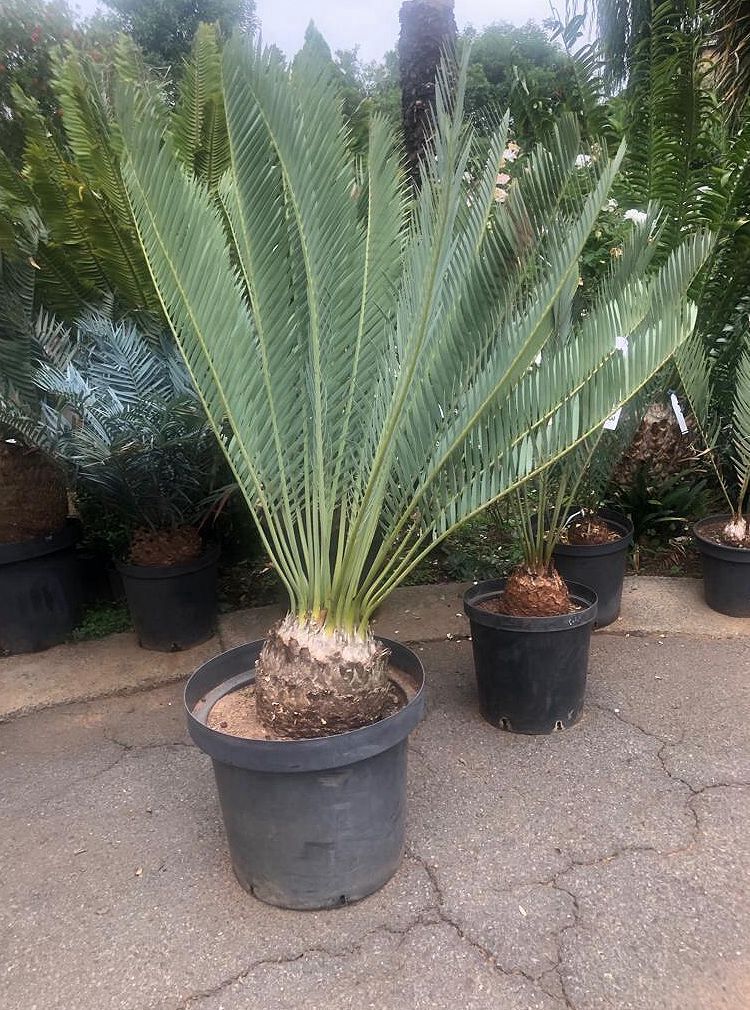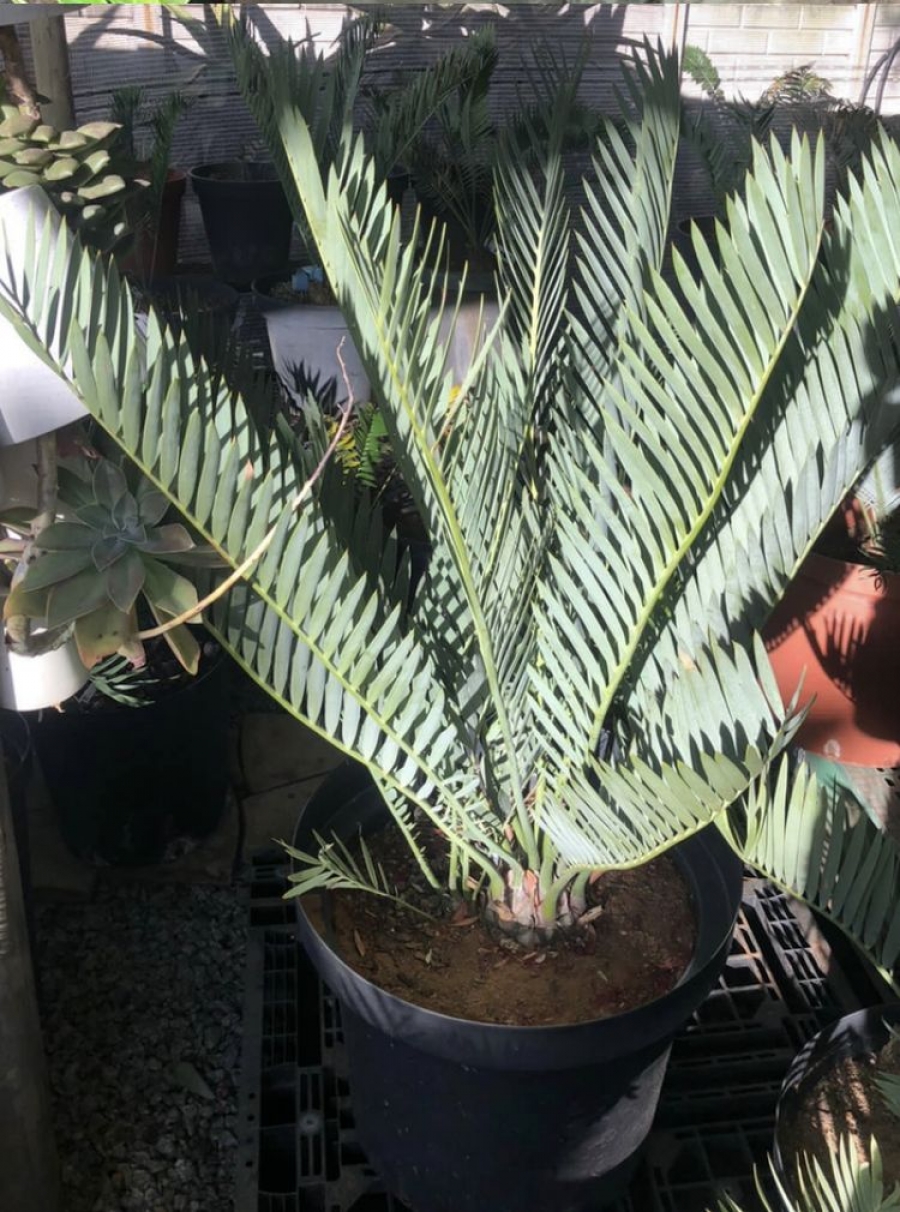|
| Division: Cycadophyta |
| Class: Cycadopsida |
| Order: Cycadales |
| Family: Zamiaceae |
| Genus: Encephalartos |
| Species: E. middelburgensis |
Conservation Status: |

E. middelburgensis
Middelburg CycadEncephalartos middelburgensis, also known as the Middelburg Cycad, is confined to the Witbank and Middelburg districts in the upper catchment areas of the Olifants River, which include the Wilge and Klein Olifants Rivers, in the provinces of Gauteng and Mpumalanga of South Africa. It is a blue-leaved cycad covered with persistent powdery bloom. It thrives in full sunlight and is frost-hardy. It is distinguished within the group of blue-leaved species of northern South Africa by its long, straight leaves with terminal part curving very slightly upwards, with entire leaflets and reddish brown cones with fine brown hairs.
E. middelburgensis is a large cycad, with an aerially unbranched, erect stem which tends to recline when long, growing in clumps of up to twelve stems and producing suckers freely from the base; the stem grows up to 7m tall with a diameter of 250-400 mm; the stem apex is characterised by inconspicuous, long and slender cataphylls (scale leaves).
The leaves are stiff, attain a length of 1.0-1.5 m, bluish-green, straight, with the apex tending to curve very slightly upwards, with persistent powdery bloom and with the same colour on both upper and lower side. Young leaves are often silvery due to a dense covering of powdery bloom. Leaflets tend to shield one another downwards but only at the leaf apex; median leaflets are leathery and without nodules, 180-190 mm long and 14-19 mm broad. The margin of the lower leaflets tends to curve upwards while that of the upper ones tends to curve downwards; the basal leaflets decrease in size, usually to one or two spines. The petiole (leaf stalk) is triangular and 100-200 mm long.
Male and female plants bear 4-8 reddish brown cones per season per stem. Male cones attain a length of up to 450-700 mm and a diameter of 85-130 mm, having a stalk up to 50-170 mm long. Female cones attain a length of up to 350-450 mm and a diameter of 170-200 mm, with a stalk up to 150 mm long which is usually obscured largely by the cataphylls of the stem. Cones of Encephalartos middelburgensis do not disintegrate spontaneously as those of the other species do, but dry out during September-October to yield 170-260 detached seeds. Seeds are yellow to light brown, with a length of 38-40 mm and a diameter of 22-24 mm.
Cultivation:
Encephalartos midddelburgensis is easily propagated from seeds and suckers (the young plants that grow around the main stem). Seedlings at the one-leaf stage are susceptible to the fungal disease 'damping off' which kills the seedling's single leaf at ground level.
The seeds should be collected, cleaned and stored in a brown paper bag at 10-15°C for six months or more, to allow the embryo to fully develop. The seeds are cleaned to ensure that all the flesh is removed since it may contain germination inhibitors and can also promote the growth of fungi. The flesh is scraped away with a knife. Protective gloves should be worn during the cleaning operation to prevent contact with the slow-acting poisons present in the flesh. If the flesh is hard and dry, it helps to soak the seeds in water for a day or two before cleaning. Even if the seeds have been cleaned, it is a good idea to soak them for a few days, preferably with daily changes of water, before planting them. When the seeds are placed in water, the viable ones will sink and the non-viable ones will float.
To germinate the seeds, place the cleaned seeds on their sides half buried on washed sand or potting mix, and keep at about 28°C. It is necessary to keep the medium moist, but not too wet, for as long as it takes for germination to take place. As soon as the radicals of the sprouted kernels are 10-20 mm long, they can be planted singly in plastic bags containing potting soil or some other suitable medium. Alternatively, one can wait until the seedlings develop one or two leaves before transplanting them individually into bags.
Because cycad seedlings form long tap roots, it is advisable to use tall narrow perforated black plastic bags about 24 x12 cm in size for their initial establishment. Place the seedlings under shade for the first few years of growth and development. Initially the seedlings must be watered daily with a fine spray. After about a month, as their roots elongate, the frequency of watering should be decreased to once a week. The seedlings can be transplanted into the garden when they are 3-5 years old.
When preparing to propagate from suckers, a hole should be dug around the stem of the mother plant to expose the base and roots of the suckers. One must use a clean sharp knife or sharp spade to remove the sucker from the mother plant. The wound should then be treated with flowers of sulphur or a fungicide such as Benlate or Kaptan and dried for about a week before planting the sucker into a sterile medium.
Cycads are ideal for a low maintenance garden, as they require a minimum of water and are undemanding in their soil and environmental needs.
Pests troublesome to cycads are scale insects, beetles and chewing insects. Scale insects cause great damage to cycad leaves by sucking the sap from them. Most scale insects can be controlled with regular and frequent applications of horticultural soluble oil such as white oil. Beetles seriously damage cycad plants by attacking the emerging young leaves. Control can be kept by application of contact or systemic insecticides, or one of the bacterial preparations available.
| full sun | blue-green | very low watering | average growth | frost-hardy | rare |
Encephalartos midddelburgensis is easily propagated from seeds and suckers (the young plants that grow around the main stem). Seedlings at the one-leaf stage are susceptible to the fungal disease 'damping off' which kills the seedling's single leaf at ground level.
The seeds should be collected, cleaned and stored in a brown paper bag at 10-15°C for six months or more, to allow the embryo to fully develop. The seeds are cleaned to ensure that all the flesh is removed since it may contain germination inhibitors and can also promote the growth of fungi. The flesh is scraped away with a knife. Protective gloves should be worn during the cleaning operation to prevent contact with the slow-acting poisons present in the flesh. If the flesh is hard and dry, it helps to soak the seeds in water for a day or two before cleaning. Even if the seeds have been cleaned, it is a good idea to soak them for a few days, preferably with daily changes of water, before planting them. When the seeds are placed in water, the viable ones will sink and the non-viable ones will float.
To germinate the seeds, place the cleaned seeds on their sides half buried on washed sand or potting mix, and keep at about 28°C. It is necessary to keep the medium moist, but not too wet, for as long as it takes for germination to take place. As soon as the radicals of the sprouted kernels are 10-20 mm long, they can be planted singly in plastic bags containing potting soil or some other suitable medium. Alternatively, one can wait until the seedlings develop one or two leaves before transplanting them individually into bags.
Because cycad seedlings form long tap roots, it is advisable to use tall narrow perforated black plastic bags about 24 x12 cm in size for their initial establishment. Place the seedlings under shade for the first few years of growth and development. Initially the seedlings must be watered daily with a fine spray. After about a month, as their roots elongate, the frequency of watering should be decreased to once a week. The seedlings can be transplanted into the garden when they are 3-5 years old.
When preparing to propagate from suckers, a hole should be dug around the stem of the mother plant to expose the base and roots of the suckers. One must use a clean sharp knife or sharp spade to remove the sucker from the mother plant. The wound should then be treated with flowers of sulphur or a fungicide such as Benlate or Kaptan and dried for about a week before planting the sucker into a sterile medium.
Cycads are ideal for a low maintenance garden, as they require a minimum of water and are undemanding in their soil and environmental needs.
Pests troublesome to cycads are scale insects, beetles and chewing insects. Scale insects cause great damage to cycad leaves by sucking the sap from them. Most scale insects can be controlled with regular and frequent applications of horticultural soluble oil such as white oil. Beetles seriously damage cycad plants by attacking the emerging young leaves. Control can be kept by application of contact or systemic insecticides, or one of the bacterial preparations available.
E. middelburgensis for sale at AfricaCycads.com:
|
|


